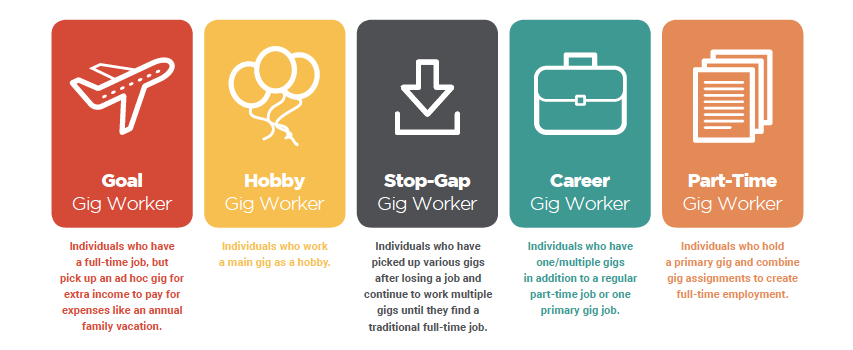
With the rise of platforms such as Uber and Postmates, the gig economy market is booming. In 2016 alone, 34 percent of the American workforce was made up of freelancers — a number projected to grow to 43 percent by 2020.
Many Americans work in the gig economy — from drivers with ridesharing platforms to even plumbers and electricians. And some of these workers are, in fact, happier working as freelancers than grinding away at a traditional nine-to-five job.
Yet some gig workers rely heavily on the gig economy for income. In fact, 44 percent of gig workers receive 40 percent or more of their income from gig economy jobs, according to the PYMNTS Gig Economy Index.
Still, some gig workers are just seeking to pursue their passions or pursue part-time work. Here are five personas of gig workers — and the industries in which they tend to work.

Goal Gig Workers
Goal gig workers tend to be highly educated with middle-to-high incomes, and 47 percent of them have at least have a four-year college degree. These are the workers getting their side hustle on — and they make up 40 percent of gig workers.
Michael Motylinski, of St. Thomas, for example, is an attorney by trade, but he also officiates weddings to bring in extra money.
“It’s a ton of fun and makes me good income on the side,” Motylinski told Forbes. “I got ordained online for my brother’s wedding. Now I get a steady stream of business.”
Stop-Gap Gig Workers
Stop-gap workers tend to favor gigs in household services and in the travel and hospitality industry. They make up 33 percent of all gig employees. For example, Uber drivers tend to “over-index in high unemployment areas,” according to the company.
When people lose their jobs or their companies cut their hours, they still have to meet obligations, such as car and housing payments. As a result, some are turning toward driving to bring in cash.
Uber claims it can help people with work opportunities in areas of high unemployment. In France, for example, the company said 25 percent its 10,000 drivers were unemployed before they came to Uber. And, of that population, 40 percent had been out of work for over a year.
Hobby Gig Workers
Hobby gig workers tend to be highly educated, relatively younger and work in health and fitness as well as the professional and personal services industries. They make up 12 percent of gig workers. Most of them value the flexibility gigs offer and do not want a full-time job.
Allie Madison, for example, started using Fiverr to market her video editing and acting services, and her venture has grown dramatically into a thriving business.
“The summer before college, I was just another 18-year-old working a minimum wage job as a lifeguard in my hometown — and I hated it,” Madison told Bustle. “One day, I was Googling ways to make money online when I came across Fiverr. I began creating commercials and promotional videos for $5, and, before I knew it, I was running a budding online business.”
Career Gig Workers
Career gig workers tend to be more concentrated in the labor workforce, making up 10 percent of gig employees. When it comes to happiness with overall lifestyle, career gig workers are almost as happy as hobby gig workers.
For example, Tomas Laurinavicius of Lithuania works as an entrepreneur and blogger focused on lifestyles. He created Despreneur, a design blog he recently sold. Now, he writes for several publications such as Forbes and The Huffington Post and travels around Bali.
“I always dreamt of freedom,” Laurinavicius told Relate by Zendesk. “It was never about the money I make, but about the wealth of options in lifestyle and business.”
Part-Time Gig Workers
Part-time gig workers are typically students who need a flexible schedule and tend to favor gigs in delivery and household services. They make up 5 percent of gig employees. For example, students reportedly compose a good portion of Instacart couriers.
At Instacart, about a quarter — or 25 percent — of its workforce are students. And at a California-based tech support startup, Eden, about 10 percent of their workforce is comprised of students.
“There’s not a better source of smart, enthusiastic [workers] than students,” Chief Executive Joe Du Bey told MarketWatch.
The Future of the Gig Economy
Overall, fueled by new online platforms, Intuit and Emergent currently report there are 4 million gig workers. And that figure could soon double as the gig economy rapidly grows.
By 2020, the number of gig workers could reach 7.7 million, which could mean more couriers for Instacart and more drivers for services such as Uber — or even workers for a platform that has yet to be invented.